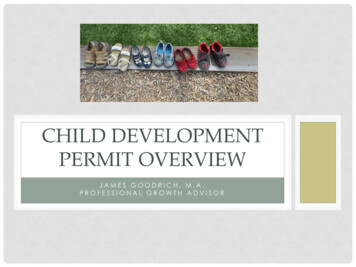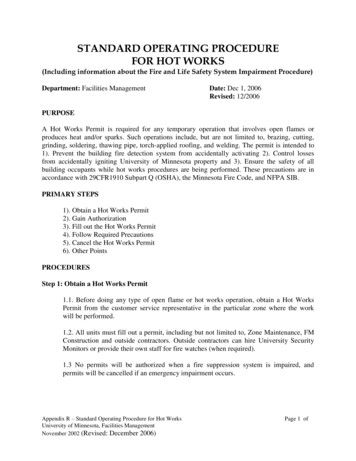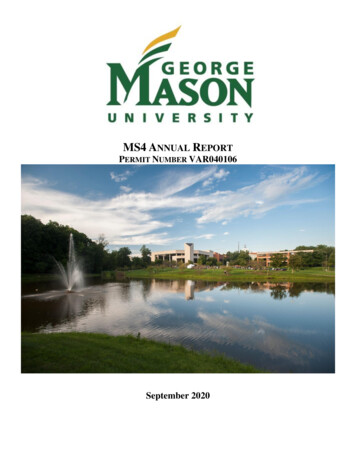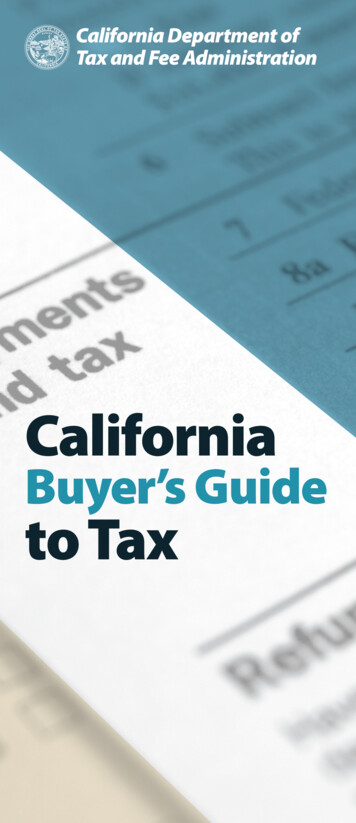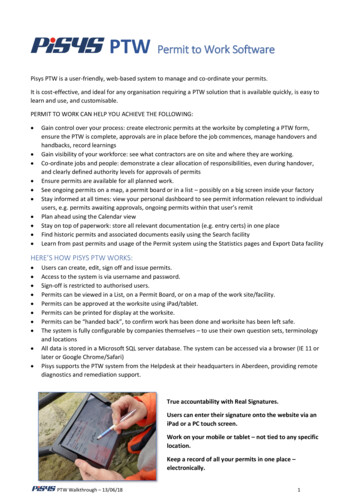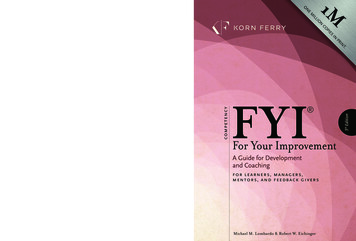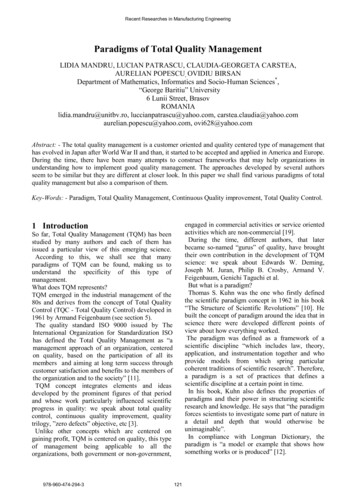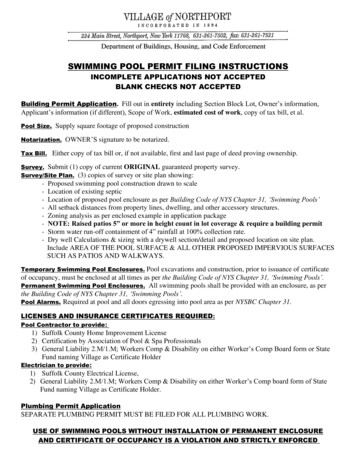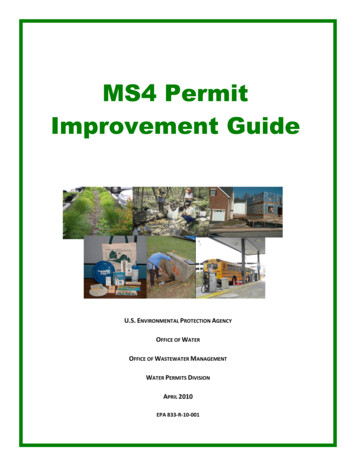
Transcription
MS4 Permit Improvement GuideMS4 PermitImprovement GuideMS4 PERMIT IMPROVEMENT GUIDEU.S. ENVIRONMENTAL PROTECTION AGENCYOFFICE OF WATEROFFICE OF WASTEWATER MANAGEMENTWATER PERMITS DIVISIONU.S. ENVIRONMENTAL PROTECTION AGENCYAPRIL 2010EPA 833-R-10-001
,.,f. '.',:' f t ;\ l '4.UNITED STATES ENVIRONMENTAL PROTECTlON AGENCYWASHINGTON 0 C 20480"APR14 al10.1 , r . Dear NPDES Stormwater Managers,W"'I( I am pleased to announce thai the Environmental Protection Agency (EPA) has completed the "MunicipalSeparate Storm Sewer System Permit Improvement Guide.- The primary purpose oflhis guidancedocument is to assist National Pollutant Discharge Elimination System (NPDES) pennit writm insmngthening municipal separate storm se.er S)Slem (MS4) permits.This Guide contains examples of permit conditions and supporting rationale that cou ld be used in factsheets that accompany NPDES permits. The Guide also inc ludes ommendations for pennit writers onhow to tailor the language depending on the type of permiL For example, permilS covering traditionalmunicipalities may contain different permit ptOvi.sion.s than those covering non-tradittonal entities likedepartments oftransponation. universities, and prisons.I ask that permit writers review the permit language and corresponding diiCussion presented in this Guideand consider how to incorporate this, or simi lar, language into their MS4 permits. Some modification ofthe language may be necessary to make it suitable for use with specinc MS4 permits. and to better tailor itto mectthe needs and goals of the various penninin& authorities.The pennit language suggested in this Guide is not intended to override already existing. more stringentor differently-worded provisions that are equally as protect i e in meeting the applicable regulations. EPAexpects the permitting authority to continue to make sig,nific:ant progreH and ensure that the intent of theregu lations or more stringent requirements is captured in the permit .In addition, EPA v.ould like to particularly stress the following key principles: Pennit provisions should be clear, specifIC. measurable. and enforceable Pennit:s shou ld inc ludespecific deadlines for compliance, incorporate clear perfonnance stand3rds, and includemeasurable goals or quantifiable targets for implementation . Permits should contain a performance standard for post nstruction that is based on the objectiveof maintaining or rC"storin& stable hydrology to protect water quality o f receiving waters Ofanother mechanism as effective.EPA has begun a rulemaking to strengthen the stormwater program. Using this Guide 10 improve permitsrepresents the direction that EPA is taking 10 strengthen the program. This Guide is a li.ing documentthat will be updated as new information for improving the stonnwater program is obtained .I appreciate your continued efforts in strengthening the NPDES municipal storm"'atcr program. (fyouhave any questions about this Guide or suggestions for further improvements. please contact RachelHerbert of my staff at herbt:r1.rxhcl1i'g-.cov or call her at 202·564· 2649.Sincerely.i:::fl. Water Permits DivisionCC:State Stonnwater CoonIinatorsAssociation of State and Interstate Water Pollution Control Administraton;flwntl s ,UR,RoM:Iyc .,cy11 t'ltIJ!1IIfkW. goo.t' P!IrMd", v ota.-d "'OII P. . . . :.rw.
MS4 Permit Improvement GuideContentsIntroduction & Getting Started.1Purpose.1Contents of this Guide .1How to Use this Guide .2Preparing to Write an MS4 Permit .3MS4 Permit Writing Tips.5The Use of Partnerships in MS4 Permits .6Chapter 1: Establishment of the Stormwater Management Program .8Introduction.81.1 Requirement to Develop a Stormwater Management Program .91.2 Requirement to Develop Adequate Legal Authority to Implement and Enforce StormwaterManagement Program .101.3 Enforcement Measures and Tracking.131.4 Requirement to Ensure Adequate Resources to Comply with MS4 Permit .16Chapter 2: Public Education and Outreach/Public Involvement.18Introduction.182.1 Developing a Comprehensive Stormwater Education/Outreach Program .182.2 Involving the Public in Planning and Implementing the SWMP .22Chapter 3: Illicit Discharge Detection and Elimination.24Introduction.243.1 IDDE Program Development.243.2 MS4 Mapping .263.3 Identification of Priority Areas .273.4 Field Screening.293.5 IDDE Source Investigation and Elimination .323.6 Public Reporting of Non-Stormwater Discharges and Spills.343.7 Illicit Discharge Education & Training .36Chapter 4: Construction .37Introduction.374.1 Construction Requirements and Control Measures .384.2 Construction Site Inventory.404.3 Construction Plan Review Procedures.414.4 Construction Site Inspections and Enforcement .434.5 MS4 Staff Training .464.6 Construction Site Operator Education & Public Involvement .47Chapter 5: Post-Construction or Permanent/Long-term Stormwater Control Measures .49Introduction.495.1 Post-Construction Stormwater Management Program .505.2 Site Performance Standards .515.3 Site Plan Review .575.4 Long-Term Maintenance of Post-Construction Stormwater Control Measures.585.5 Watershed Protection .595.6 Tracking of Post-Construction Stormwater Control Measures.625.7 Inspections and Enforcement.635.8 Retrofit Plan.64ii
MS4 Permit Improvement GuideChapter 6: Pollution Prevention/Good Housekeeping.67Introduction.676.1 Municipal Facility and Control Inventory .686.2 Facility Assessment.706.3 Development of Facility-Specific Stormwater Management SOPs and Implementation of FacilityStormwater Controls.716.4 Storm Sewer System Maintenance Activities.746.5 Flood Management .816.6 Pesticide, Herbicide, and Fertilizer Application and Management .826.7 Training and Education.836.8 Contractor Requirements and Oversight.84Chapter 7: Industrial Stormwater Sources .85Introduction.857.1 Facility Inventory .857.2 Industrial Facility Stormwater Control Measures.887.3 Industrial and Commercial Facility Inspections .917.4 Staff Training .94Chapter 8: Monitoring, Evaluation, and Reporting .95Introduction.958.1 Consolidated Information Tracking System.958.2 Development of a Comprehensive Monitoring & Assessment Program.978.3 Evaluation of Overall Program Effectiveness.1028.4 Requirements for Annual Reporting of MS4 Activities.104Appendix A: Summary Annual Report Template .107Appendix B: Definitions.108iii
MS4 Permit Improvement GuideINTRODUCTION & GETTING STARTEDPurposeThe primary purpose of the MS4 Permit Improvement Guide (Guide) is to assist National PollutantDischarge Elimination System (NPDES) permit writers in strengthening municipal separate storm sewersystem (MS4) stormwater permits. The objective of the Guide is to facilitate the creation of MS4 permitswhich are clear, consistent with applicable regulations, and enforceable. This Guide contains examplesof permit conditions and supporting rationale that could be used in fact sheets that accompany NPDESpermits. Permit language should include controls that identify specific actions permittees must performto comply with the Permit Requirements.This Guide focuses in large part on permits for small (Phase II) MS4s. However, while the contents of theGuide are generally organized consistent with the six minimum control measures (40 CFR 123.34(b))applicable to Phase II MS4 permits, however, permit writers may find this Guide useful for Phase I MS4permits. In addition, the Guide specifically addresses Phase I MS4 Permit Requirements with regard tothe industrial program elements set forth in the Phase I regulations at 40 CFR 122.26(d)(2)(ii) and (iv)(C).These are addressed in Chapter 7. The Guide may also be useful for “non-traditional” MS4 permittees,such as departments of transportation (DOTs), universities and prisons.EPA has developed a Stormwater Phase II Final Rule Fact Sheet Series(www.epa.gov/npdes/stormwater/swfinal) to assist permitting authorities and permittees inunderstanding the Phase II regulations. Further, EPA has developed the National Menu of StormwaterBest Management Practices (www.epa.gov/npdes/stormwater/menuofbmps) which providesdescriptive information in fact sheets about various best management practices associated with thePhase II six minimum control measures.The Guide was created by reviewing numerous MS4 permits and fact sheets from around the country.Some of the example permit and fact sheet language presented in this Guide has been adapted fromthese permits; in those instances where existing language that meets the purpose of this document wasnot available, EPA has crafted new language.Contents of this GuideThis document is divided into parts, as noted above, based largely on the six minimum control measuresrequired in the Phase II stormwater regulations (see 40 CFR 122.34(b)). Chapters 1 -6 addressdevelopment and implementation of a stormwater management program (SWMP) and the six minimumcontrol measures that must be included in the SWMP. Chapter 7 addresses industrial facilities programsrelevant for Phase I MS4 permits. Chapter 8, Overall Evaluation and Adaptive Management, discussesreporting, evaluation, and tracking requirements. This Guide does not focus on the water qualityprovisions of the Clean Water Act, which may require more stringent requirements than thoseprogrammatic elements specified here.Introduction & Getting Started1
MS4 Permit Improvement GuideEach chapter opens with an introduction providing a brief overview of relevant regulatory requirementspertaining to the subject of the chapter. Each chapter is then divided into sections in which thefollowing topics are addressed: Example Permit Provision – This section includes example MS4 permit language. Thelanguage has been formatted and numbered in such a way that each section correspondsdirectly to a permit structured in accordance with the chapter sequence of this Guide. EPAdeveloped these examples by first surveying existing EPA and State MS4 permit languageand drawing upon agency experience in implementing permits. EPA has identified thesource of the language (in footnotes) if adapted from specific permits. Example Permit Requirement Rationale for the Fact Sheet – This section describes therationale for the example permit provision. This language can assist the permit writer indeveloping the fact sheet, which accompanies all NPDES permits; however, it is up to thepermit writer to ensure that a complete and customized version of the fact sheetaccompanies the permit. Example Permit Requirement Rationale for the Fact Sheet sectionsoften describe “requirements” or steps that “must” be taken. To the extent this language isused in these sections, it is intended to describe requirements included in the examplepermit provisions. It does not mean that all permits ”must” include the specific“requirement” described. Recommendations for the Permit Writer (included where appropriate) – This sectiondiscusses issues the permit writer should consider in determining how to use the examplepermit provisions.How to Use this GuideThis guidance includes “example” MS4 permit language for specific program elements, but is notintended to be definitive or comprehensive for all MS4 Permit Requirements. 1 EPA recommends thatpermit writers review the example permit language presented in this guide and consider how toincorporate this, or similar, language into MS4 permits as appropriate. Each state may have differentNPDES requirements along with varied experience overseeing MS4 programs, and MS4 permittees varywidely in storm water management experience and sophistication, size, topography, precipitationpatterns, land use, receiving water conditions and other factors. In most instances, EPA anticipates thatpermit writers will modify the language to make it suitable for specific MS4 permits, and to tailorexample provisions to meet the various needs and goals that apply.When possible, this Guide has tried to provide examples that can be used for both Phase I and Phase IIpermits. However, in some instances EPA has provided suggestions for how the language can be tailoredto better fit within the context of a Phase I or Phase II permit. In addition, EPA acknowledges that somelanguage presented in this Guide may be more suitable for an individual permit rather than a generalpermit. While EPA has presented a discussion for ways the language could be altered to fit thesescenarios in Recommendations for the Permit Writer sections, it is up to the permit writer to determinethe best use of the material for the permit being crafted.1For example, the guide does not explicitly address provisions for compliance with CWA section 402(p)(3)(B)(ii),water quality standards, applicable wasteload allocations in TMDLs or such other conditions as the permittingauthority deems necessary. For information on integrating TMDLs into stormwater permits see USEPA’s DRAFTTMDLs to Stormwater Handbook (www.epa.gov/owow/tmdl/stormwater)Introduction & Getting Started2
MS4 Permit Improvement GuideThe example permit language in this Guide has been written as if the permit is a reissued permit and notan initial permit, since most MS4 permittees have been subject to NPDES permits for at least one permitterm. Requirements to develop the initial SWMP are not included in this Guide since they would havebeen included in the first permit term. It is important that permit writers consider the different stages inthe development and implementation of SWMPs when establishing permit conditions as well as theexperience learned from other more advance programs. So, for example, this Guide includes bracketsto indicate the place for an appropriate schedule or deadline rather than indicating specific timeframesin all instances. These examples are available to the permit writer, along with other resources such asthe permittee’s draft or existing SMWP document, annual reports, prior permit experience, receivingwater quality information and the permit writer’s best professional judgment, to issue permits suitablefor their specific MS4s.The permit language suggested in this Guide is not intended to override already existing, more stringentor differently-worded provisions that are equally as compliant in meeting the applicable regulations andprotective of water quality standards. EPA expects the permitting authority to ensure that the intent ofall applicable regulations is captured in the permit. States with more stringent permit provisions shouldcontinue to strengthen these provisions as the permits are reissued. This Guide includes suggestions onhow to develop permit language for MS4 permittees. This Guide does not impose any new legallybinding requirements on EPA, States, or the regulated community, and does not confer legal rights orimpose legal obligations upon any member of the public. In the event of a conflict between thediscussion in this Guide and any statute, regulation, or permit the statute, regulation or permit controls.Terminology: SWMP and SWMP DocumentThis guide uses the term SWMP to refer to the stormwater management program that is required by thePhase I and Phase II regulations to be developed by MS4 permittees. The SWMP document is the written planthat is used to describe the various control measures and activities the permittee will undertake to implementthe stormwater management program.Preparing to Write an MS4 PermitMost Phase II MS4 permittees are regulated under a general permit (with some exceptions whereindividual permits have been used for Phase II and non-traditional MS4 permittees). Phase I MS4permittees are regulated under individual permits, and can include multiple co-permittees. EPAregulations require that initial MS4 permits (i.e. first permit term) set the foundation of the permittee’sSWMP. For Phase II MS4 the focus is on the six minimum control measures in 40 C.F.R. 122.34(b), whilethe Phase I MS4 permittees are informed by the regulations at 40 C.F.R. 122.26(d). See Chapter 1 of thisGuide.As the permit writer prepares to reissue an MS4 permit, regardless of whether the permit is anindividual or general permit, EPA recommends that the permit writer review, at a minimum, thefollowing sources of information:Past annual reportsFor currently regulated MS4s, annual reports submitted by the permittee can include informationthat will help permit writers develop more specific and measurable Permit Requirements. The mostrecent annual report is usually the most helpful to review, but additional annual reports can bereviewed if time allows. If the permit writer is developing a general permit, a broad selection ofIntroduction & Getting Started3
MS4 Permit Improvement Guideannual reports from various permittees should be reviewed. In particular, EPA recommends thatthe permit writer review, at a minimum, the following specific information:Areas of obvious strengths or weaknesses in the SWMP For example, is the permittee vague about specific activities (often an indicator of a weakprogram area), or is the permittee clearly meeting the requirements of the permit and/orgoing above and beyond the minimum requirements?Trends or common compliance problems For example, does the permittee analyze the data to assess the most common complianceproblems, and then modify their controls/programs to address these problems? Forexample, do they use the common compliance issues identified to target their training andoutreach/education efforts for construction operators?Level of implementation of SWMP activities (e.g., frequency and numbers of inspections,frequency of catch basin cleaning, street sweeping) Does the permittee report the total universe when reporting the quantity of an activityachieved? For example, if the MS4 is required to conduct industrial inspections, does itreport it did 100 inspections (which may be good or bad, depending on how many it wasrequired to inspect), or that it did 100 out of 5,000 (only 2% of the total)?Water quality priorities for the permittee (e.g. impaired waters, TMDLs, high quality waters) Does the permittee’s annual report describe priority pollutants for impaired waters andother water quality programs and what was done to reduce and/or eliminate their contactwith stormwater? Does the SWMP target both impaired and high quality waters?Specific sources or pollutants of concern permittee is currently focusing on Does the SWMP target pollutants of concern in its activities?Level and type of enforcement currently being used by permittee Does the annual report provide data and summary information on the different types ofenforcement actions taken (how many verbal warnings, written notes, fines, etc)?Any trends (i.e. water quality, compliance, control measure implementation levels) beingreported by Permittees which indicate success or failure of particular SWMP components Does the permittee analyze the data, or just report the data in the MS4 annual report?Types of measurable goals being applied and achieved by permittees Has the permittee met the measurable goals stated in the permit and SWMP?Introduction & Getting Started4
MS4 Permit Improvement GuideStormwater management program (SWMP)Review the most current SWMP documents for potential gaps that may need to be specificallyaddressed in the reissued MS4 permit. EPA’s MS4 Program Evaluation Guidance (available atwww.epa.gov/npdes/pubs/ms4guide withappendixa.pdf) can be used to assess the key elements ina SWMP.NPDES MS4 audit reports, construction/industrial/commercial site inspection reportsReview the findings from any MS4 audits conducted during the past permit term to help identify keyissues that should be addressed in the next permit. For example, if the audits identified weak ormissing program elements and other controls, these should be addressed in the reissuance of thepermit. Construction, industrial, and/or commercial site inspection reports for facilities within theMS4’s boundary should be reviewed to determine if there are common compliance issues thatshould be addressed in the MS4 permit (for example, more training, more frequent inspections,more complete inventory or prioritization, etc.).Monitoring/Information on Quality of Receiving WatersReview any monitoring data collected by the permittee or any other entity that has collected usefulmonitoring data to identify potential pollutants of concern. In addition, the most recent informationon impaired waters and total maximum daily loads (TMDLs) for the permit area should be reviewed.If there are waste load allocations (WLAs) applicable to the permittee, these should be addressed inthe permit. If no WLA has been assigned to the MS4, the permit writer should still considerpollutants of concern identified in 303(d) lists and TMDLs when developing Permit Requirements.Such information will help identify whether more targeted permit conditions are needed to reducethe discharge of these pollutants. This Guide does not specifically address the inclusion of TMDLrequirements in MS4 permits.Permit renewal application data or past notice of intent (NOI) informationReview any permit renewal applications or NOIs submitted to establish coverage for the previouspermit term. Permit writers should consider the recommendations made in the EPA “InterpretivePolicy Memorandum on Reapplication Requirements for Municipal Separate Storm Sewer Systems”(www.epa.gov/npdes/pubs/owm0125.pdf) published in 1996 (40 CFR Part 122; Federal Register,Volume 61, Number 155). This document provides information which clarifies the MS4reapplication requirements and explains that MS4 permit applicants and NPDES permit writers havediscretion to customize appropriate and streamlined reapplication requirements on a case-by-casebasis.Previous MS4 permitFinally, review any past MS4 permits to identify where permit language should be revised orcompletely rewritten, for example, because language was vague. This MS4 permit improvementGuide should be used help strengthen key areas in the permit.Note that if the MS4 permit is being issued for the first time, some of the above information will notexist yet, such as past annual reports or old SWMP documents.MS4 Permit Writing TipsThere are a few general tips to keep in mind when writing MS4 permits. First, and most importantly,permit provisions should be clear, specific, measurable, and enforceable. Permits should include specificIntroduction & Getting Started5
MS4 Permit Improvement Guidedeadlines for compliance, incorporate clear performance standards, and includ
scenarios in Recommendations for the Permit Writer sections, it is up to the permit writer to determine the best use of the material for the permit being crafted. 1. For example, the guide does not explicitly address pro
